
Arab-Norman culture
Encyclopedia
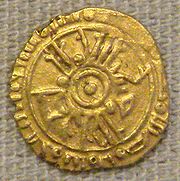
Normans
The Normans were the people who gave their name to Normandy, a region in northern France. They were descended from Norse Viking conquerors of the territory and the native population of Frankish and Gallo-Roman stock...
, Arab
Arab
Arab people, also known as Arabs , are a panethnicity primarily living in the Arab world, which is located in Western Asia and North Africa. They are identified as such on one or more of genealogical, linguistic, or cultural grounds, with tribal affiliations, and intra-tribal relationships playing...
and Byzantine
Byzantine
Byzantine usually refers to the Roman Empire during the Middle Ages.Byzantine may also refer to:* A citizen of the Byzantine Empire, or native Greek during the Middle Ages...
culture following the Norman conquest of Sicily from 1061, to around 1250. This civilization resulted from numerous exchanges in the cultural and scientific fields, based on the tolerance showed by the Normans towards the Greek
Greek language
Greek is an independent branch of the Indo-European family of languages. Native to the southern Balkans, it has the longest documented history of any Indo-European language, spanning 34 centuries of written records. Its writing system has been the Greek alphabet for the majority of its history;...
-speaking population and the Muslim settlers. As a result, Sicily
Sicily
Sicily is a region of Italy, and is the largest island in the Mediterranean Sea. Along with the surrounding minor islands, it constitutes an autonomous region of Italy, the Regione Autonoma Siciliana Sicily has a rich and unique culture, especially with regard to the arts, music, literature,...
under the Normans became a crossroad for the interaction between the Latin-Christian, Greek-Byzantine and Arab-Islamic cultures.
Norman conquest of Southern Italy
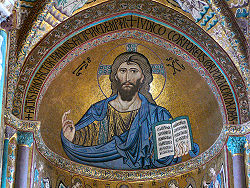
History of Islam in southern Italy
The history of Islam in southern Italy begins with the Islamic conquest and subsequent rule of Sicily and Malta, a process that started in the 9th century. Islamic rule over Sicily was effective from 902, and the complete rule of the island lasted from 965 until 1061...
in 965, the Normans managed to conquer the island starting in 1060. The Normans had been expanding south, driven by the myth of a happy and sunny island in the Southern Seas. The Norman Robert Guiscard
Robert Guiscard
Robert d'Hauteville, known as Guiscard, Duke of Apulia and Calabria, from Latin Viscardus and Old French Viscart, often rendered the Resourceful, the Cunning, the Wily, the Fox, or the Weasel was a Norman adventurer conspicuous in the conquest of southern Italy and Sicily...
("the cunning"), son of Tancred
Tancred
Tancred may refer to:* Tancred Tancred of Hauteville** Tancred of Hauteville, founder of the Hauteville family** Tancred, Prince of Galilee, a leader of the First Crusade...
, invaded Sicily
Norman conquest of southern Italy
The Norman conquest of southern Italy spanned the late eleventh and much of the twelfth centuries, involving many battles and many independent players conquering territories of their own...
in 1060. The island was split between three Arab emir
Emirate
An emirate is a political territory that is ruled by a dynastic Muslim monarch styled emir.-Etymology:Etymologically emirate or amirate is the quality, dignity, office or territorial competence of any emir ....
s, and the sizable Christian population rebelled against the ruling Muslims. One year later Messina fell under the leadership of Roger I of Sicily
Roger I of Sicily
Roger I , called Bosso and the Great Count, was the Norman Count of Sicily from 1071 to 1101. He was the last great leader of the Norman conquest of southern Italy.-Conquest of Calabria and Sicily:...
, and in 1071, Palermo was taken by the Normans. The loss of the cities, each with a splendid harbor, dealt a severe blow to Muslim power on the island. Eventually all of Sicily was taken. In 1091, Noto
Noto
Noto is a city and comune in the Province of Syracuse, Sicily . Its located 32 km southwest of the city of Syracuse at the foot of the Iblean Mountains and gives its name to the surrounding valley, Val di Noto...
in the southern tip of Sicily and the island of Malta
Malta
Malta , officially known as the Republic of Malta , is a Southern European country consisting of an archipelago situated in the centre of the Mediterranean, south of Sicily, east of Tunisia and north of Libya, with Gibraltar to the west and Alexandria to the east.Malta covers just over in...
, the last Arab strongholds, fell to the Christians. By the 11th century Muslim power in the Mediterranean had begun to wane. Under Norman rule, Palermo
Palermo
Palermo is a city in Southern Italy, the capital of both the autonomous region of Sicily and the Province of Palermo. The city is noted for its history, culture, architecture and gastronomy, playing an important role throughout much of its existence; it is over 2,700 years old...
confirmed its role of one of the great capitals of the Mediterranean.
Cultural interactions
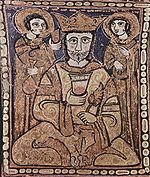


One of the greatest geographical treatises of the Middle Ages was written by the Andalusian
Al-Andalus
Al-Andalus was the Arabic name given to a nation and territorial region also commonly referred to as Moorish Iberia. The name describes parts of the Iberian Peninsula and Septimania governed by Muslims , at various times in the period between 711 and 1492, although the territorial boundaries...
Muhammad al-Idrisi
Muhammad al-Idrisi
Abu Abd Allah Muhammad al-Idrisi al-Qurtubi al-Hasani al-Sabti or simply Al Idrisi was a Moroccan Muslim geographer, cartographer, Egyptologist and traveller who lived in Sicily, at the court of King Roger II. Muhammed al-Idrisi was born in Ceuta then belonging to the Almoravid Empire and died in...
for Roger, and entitled Kitab Rudjdjar
Tabula Rogeriana
The Nuzhat al-mushtaq fi'khtiraq al-afaq lit. "the book of pleasant journeys into faraway lands", most often known as the Tabula Rogeriana , is a description of the world and world map created by the Arab geographer, Muhammad al-Idrisi, in 1154...
("The book of Roger"). The Norman Kingdom of Sicily
Kingdom of Sicily
The Kingdom of Sicily was a state that existed in the south of Italy from its founding by Roger II in 1130 until 1816. It was a successor state of the County of Sicily, which had been founded in 1071 during the Norman conquest of southern Italy...
under Roger II was characterised by its multi-ethnic nature and religious tolerance. Normans, Muslim Arabs, Byzantine Greeks, Longobards and "native" Sicilians lived in harmony. He dreamed of establishing an Empire that would have encompassed Fatimid
Fatimid
The Fatimid Islamic Caliphate or al-Fāṭimiyyūn was a Berber Shia Muslim caliphate first centered in Tunisia and later in Egypt that ruled over varying areas of the Maghreb, Sudan, Sicily, the Levant, and Hijaz from 5 January 909 to 1171.The caliphate was ruled by the Fatimids, who established the...
Egypt
Egypt
Egypt , officially the Arab Republic of Egypt, Arabic: , is a country mainly in North Africa, with the Sinai Peninsula forming a land bridge in Southwest Asia. Egypt is thus a transcontinental country, and a major power in Africa, the Mediterranean Basin, the Middle East and the Muslim world...
and the Crusader states in the Levant.
Although the language of the court was French
French language
French is a Romance language spoken as a first language in France, the Romandy region in Switzerland, Wallonia and Brussels in Belgium, Monaco, the regions of Quebec and Acadia in Canada, and by various communities elsewhere. Second-language speakers of French are distributed throughout many parts...
(Langue d'oïl
Langues d'oïl
The langues d'oïl or langues d'oui , in English the Oïl or Oui languages, are a dialect continuum that includes standard French and its closest autochthonous relatives spoken today in the northern half of France, southern Belgium, and the Channel Islands...
), all royal edicts were written in the language of the people they were addressed to: Latin
Latin
Latin is an Italic language originally spoken in Latium and Ancient Rome. It, along with most European languages, is a descendant of the ancient Proto-Indo-European language. Although it is considered a dead language, a number of scholars and members of the Christian clergy speak it fluently, and...
, Greek
Medieval Greek
Medieval Greek, also known as Byzantine Greek, is the stage of the Greek language between the beginning of the Middle Ages around 600 and the Ottoman conquest of the city of Constantinople in 1453. The latter date marked the end of the Middle Ages in Southeast Europe...
, Arabic
Arabic language
Arabic is a name applied to the descendants of the Classical Arabic language of the 6th century AD, used most prominently in the Quran, the Islamic Holy Book...
, or Hebrew
Hebrew language
Hebrew is a Semitic language of the Afroasiatic language family. Culturally, is it considered by Jews and other religious groups as the language of the Jewish people, though other Jewish languages had originated among diaspora Jews, and the Hebrew language is also used by non-Jewish groups, such...
. Roger's royal mantel, used for his coronation (and also used for the coronation of Frederick II
Frederick II, Holy Roman Emperor
Frederick II , was one of the most powerful Holy Roman Emperors of the Middle Ages and head of the House of Hohenstaufen. His political and cultural ambitions, based in Sicily and stretching through Italy to Germany, and even to Jerusalem, were enormous...
), bore an inscription in Arabic with the Hijri
Hijri year
The Hijri year is year numbering system used in the Islamic calendar. It commemorates the Hijra , or emigration of Muhammad and his followers to the city of Medina in 622 CE. In Arabic, AH is symbolized by the letter هـ...
date of 528 (1133-1134).
Islamic authors would marvel at the tolerance of the Norman kings:
They [the Muslims] were treated kindly, and they were protected, even against the Franks. Because of that, they had great love for king Roger.
Ibn al-Athir
Interactions continued with the succeeding Norman kings, for example under William II of Sicily
William II of Sicily
William II , called the Good, was king of Sicily from 1166 to 1189. William's character is very indistinct. Lacking in military enterprise, secluded and pleasure-loving, he seldom emerged from his palace life at Palermo. Yet his reign is marked by an ambitious foreign policy and a vigorous diplomacy...
, as attested by the Spanish-Arab geographer Ibn Jubair who landed in the island after returning from a pilgrimage to Mecca in 1184. To his surprise, Ibn Jubair enjoyed a very warm reception by the Norman Christians. He was further surprised to find that even the Christians spoke Arabic, that the government officials were still largely Muslim, and that the heritage of some 130 previous years of Muslim rule of Sicily was still intact:
The attitude of the king is really extraordinary. His attitude towards the Muslims is perfect: he gives them employment, he choses his officers among them, and all, or almost all, keep their faith secret and can remain faithful to the faith of Islam. The king has full confidence in the Muslims and relies on them to handle many of his affairs, including the most important ones, to the point that the Great Intendant for cooking is a Muslim (...) His vizierVizierA vizier or in Arabic script ; ; sometimes spelled vazir, vizir, vasir, wazir, vesir, or vezir) is a high-ranking political advisor or minister in a Muslim government....
s and chamberlainChamberlain (office)A chamberlain is an officer in charge of managing a household. In many countries there are ceremonial posts associated with the household of the sovereign....
s are eunuchs, of which there are many, who are the members of his government and on whom he relies for his private affairs.
Ibn Jubair, Rihla.
Ibn Jubair also mentioned that many Christians in Palermo
Palermo
Palermo is a city in Southern Italy, the capital of both the autonomous region of Sicily and the Province of Palermo. The city is noted for its history, culture, architecture and gastronomy, playing an important role throughout much of its existence; it is over 2,700 years old...
wore the Muslim dress, and many spoke Arabic. The Norman kings also continued to strike coins in Arabic with Hegira dates. The registers at the Royal court were written in Arabic. At one point, William II of Sicily
William II of Sicily
William II , called the Good, was king of Sicily from 1166 to 1189. William's character is very indistinct. Lacking in military enterprise, secluded and pleasure-loving, he seldom emerged from his palace life at Palermo. Yet his reign is marked by an ambitious foreign policy and a vigorous diplomacy...
is recorded to have said: “Everyone of you should invoke the one he adores and of whom he follows the faith”.
Norman-Arab-Byzantine art
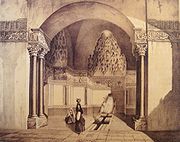
Ivory
Ivory is a term for dentine, which constitutes the bulk of the teeth and tusks of animals, when used as a material for art or manufacturing. Ivory has been important since ancient times for making a range of items, from ivory carvings to false teeth, fans, dominoes, joint tubes, piano keys and...
or porphyry
Porphyry (geology)
Porphyry is a variety of igneous rock consisting of large-grained crystals, such as feldspar or quartz, dispersed in a fine-grained feldspathic matrix or groundmass. The larger crystals are called phenocrysts...
, sculpture of hard stones, bronze foundries, manufacture of silk (for which Roger II established a regium ergasterium, a state enterprise which would give Sicily the monopoly of silk manufacture for all Europe).
Norman-Arab-Byzantine architecture

The Church of Saint-John of the Hermits, was built in Palermo
Palermo
Palermo is a city in Southern Italy, the capital of both the autonomous region of Sicily and the Province of Palermo. The city is noted for its history, culture, architecture and gastronomy, playing an important role throughout much of its existence; it is over 2,700 years old...
by Roger II around 1143-1148 in such a style. The church is notable for its brilliant red domes, which show clearly the persistence of Arab influences in Sicily at the time of its reconstruction in the 12th century. In his Diary of an Idle Woman in Sicily, F. Elliot described it as "... totally oriental... it would fit well in Baghdad
Baghdad
Baghdad is the capital of Iraq, as well as the coterminous Baghdad Governorate. The population of Baghdad in 2011 is approximately 7,216,040...
or Damascus
Damascus
Damascus , commonly known in Syria as Al Sham , and as the City of Jasmine , is the capital and the second largest city of Syria after Aleppo, both are part of the country's 14 governorates. In addition to being one of the oldest continuously inhabited cities in the world, Damascus is a major...
". The bell tower, with four orders of arcaded loggias, is instead a typical example of Gothic architecture
Gothic architecture
Gothic architecture is a style of architecture that flourished during the high and late medieval period. It evolved from Romanesque architecture and was succeeded by Renaissance architecture....
.
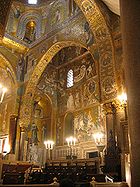
Cappella Palatina
The Palatine Chapel is the royal chapel of the Norman kings of Sicily situated on the ground floor at the center of the Palazzo Reale in Palermo, southern Italy....
, also in Palermo, combines harmoniously a variety of styles: the Norman architecture
Norman architecture
About|Romanesque architecture, primarily English|other buildings in Normandy|Architecture of Normandy.File:Durham Cathedral. Nave by James Valentine c.1890.jpg|thumb|200px|The nave of Durham Cathedral demonstrates the characteristic round arched style, though use of shallow pointed arches above the...
and door decor, the Arabic arches and scripts adorning the roof, the Byzantine dome and mosaics. For instance, clusters of four eight-pointed stars, typical for Muslim design, are arranged on the ceiling so as to form a Christian cross
Cross
A cross is a geometrical figure consisting of two lines or bars perpendicular to each other, dividing one or two of the lines in half. The lines usually run vertically and horizontally; if they run obliquely, the design is technically termed a saltire, although the arms of a saltire need not meet...
.
The Monreale
Monreale
Monreale is a town and comune in the province of Palermo, in Sicily, Italy, on the slope of Monte Caputo, overlooking the very fertile valley called "La Conca d'oro" , famed for its orange, olive and almond trees, the produce of which is exported in large quantities...
cathedral is generally described as "Norman-Arab-Byzantine". The outsides of the principal doorways and their pointed arches are magnificently enriched with carving and colored inlay, a curious combination of three styles — Norman-French, Byzantine and Arab.
Other examples of Arab-Norman architecture include the Palazzo dei Normanni
Palazzo dei Normanni
The Palazzo dei Normanni or Royal Palace of Palermo is a palace in Palermo, Italy. It was the seat of the Kings of Sicily during the Norman domination and served afterwards as the main seat of power for the subsequent rulers of Sicily...
, or Castelbuono
Castelbuono
Castelbuono is a town and comune in the province of Palermo, Sicily . It is especially famous for the castle which its name derives, and around which the city grew up in the 14th century.-History:...
. This style of construction would persist until the 14th and the 15th century, exemplified by the use of the cupola
Cupola
In architecture, a cupola is a small, most-often dome-like, structure on top of a building. Often used to provide a lookout or to admit light and air, it usually crowns a larger roof or dome....
.
Arab-Norman law
A significant influence on Norman lawNorman law
Norman law refers to the customary law of Normandy which developed between the 10th and 13th centuries following the establishment of the Vikings there and which survives today still through the legal systems of Jersey and Guernsey in the Channel Islands....
came from Islamic law
Sharia
Sharia law, is the moral code and religious law of Islam. Sharia is derived from two primary sources of Islamic law: the precepts set forth in the Quran, and the example set by the Islamic prophet Muhammad in the Sunnah. Fiqh jurisprudence interprets and extends the application of sharia to...
and jurisprudence
Fiqh
Fiqh is Islamic jurisprudence. Fiqh is an expansion of the code of conduct expounded in the Quran, often supplemented by tradition and implemented by the rulings and interpretations of Islamic jurists....
after the Normans
Normans
The Normans were the people who gave their name to Normandy, a region in northern France. They were descended from Norse Viking conquerors of the territory and the native population of Frankish and Gallo-Roman stock...
had conquered the Emirate of Sicily
Emirate of Sicily
The Emirate of Sicily was an Islamic state on the island of Sicily , which existed from 965 to 1072.-First Arab invasions of Sicily:...
and inherited its Islamic legal administration.
Transmission to Europe
The points of contact between Europe and Islamic lands were multiple during the Middle Ages, with Sicilia playing a key role in the transmission of knowledge to Europe, although less important than that of Spain. The main points of transmission of Islamic knowledge to Europe were in Sicilia, and in Islamic SpainAl-Andalus
Al-Andalus was the Arabic name given to a nation and territorial region also commonly referred to as Moorish Iberia. The name describes parts of the Iberian Peninsula and Septimania governed by Muslims , at various times in the period between 711 and 1492, although the territorial boundaries...
, particularly in Toledo
Toledo, Spain
Toledo's Alcázar became renowned in the 19th and 20th centuries as a military academy. At the outbreak of the Spanish Civil War in 1936 its garrison was famously besieged by Republican forces.-Economy:...
(with Gerard of Cremone, 1114-1187, following the conquest of the city by the Spanish Christians in 1085). Many exchanges also occurred in the Levant
Levant
The Levant or ) is the geographic region and culture zone of the "eastern Mediterranean littoral between Anatolia and Egypt" . The Levant includes most of modern Lebanon, Syria, Jordan, Israel, the Palestinian territories, and sometimes parts of Turkey and Iraq, and corresponds roughly to the...
due to the presence of the Crusaders
Crusaders
The Crusaders are a New Zealand professional rugby union team based in Christchurch that competes in the Super Rugby competition. They are the most successful team in Super Rugby history with seven titles...
there.
Aftermath
.jpg)
Constance of Sicily
Constance of Hauteville was the heiress of the Norman kings of Sicily and the wife of Henry VI, Holy Roman Emperor...
, and was replaced by that of the Swabia
Swabia
Swabia is a cultural, historic and linguistic region in southwestern Germany.-Geography:Like many cultural regions of Europe, Swabia's borders are not clearly defined...
n Hohenstaufen Dynasty. Constance's son Frederick II, Holy Roman Emperor
Frederick II, Holy Roman Emperor
Frederick II , was one of the most powerful Holy Roman Emperors of the Middle Ages and head of the House of Hohenstaufen. His political and cultural ambitions, based in Sicily and stretching through Italy to Germany, and even to Jerusalem, were enormous...
and King of Sicily in the early 13th century, who was Norman by his mother and Swabian by his father Emperor Henry VI
Henry VI, Holy Roman Emperor
Henry VI was King of Germany from 1190 to 1197, Holy Roman Emperor from 1191 to 1197 and King of Sicily from 1194 to 1197.-Early years:Born in Nijmegen,...
, spoke Arabic and had several Muslim ministers.
In 1224 however, Frederick II, responding to religious uprisings in Sicily, expelled all Muslims from the island, transferring many to Lucera
Lucera
Lucera is a town and comune in the Province of Foggia, in the Apulia region of southern Italy.-Ancient era and early Middle Ages :Lucera is an ancient city founded in Daunia, the centre of Dauni territory . Archeological excavations show the presence of a bronze age village inside the city boundaries...
over the next two decades. In this controlled environment, they couldn't challenge royal authority and they benefited the crown in taxes and military service. Their numbers eventually reached between 15,000 and 20,000, leading Lucera to be called Lucaera Saracenorum because it represented the last stronghold of Islamic presence in Italy. The colony thrived for 75 years until it was sacked in 1300 by Christian forces under the command of Charles II of Naples
Charles II of Naples
Charles II, known as "the Lame" was King of Naples, King of Albania, Prince of Salerno, Prince of Achaea and Count of Anjou.-Biography:...
. The city's Muslim inhabitants were exiled or sold into slavery, with many finding asylum in Albania
Albania
Albania , officially known as the Republic of Albania , is a country in Southeastern Europe, in the Balkans region. It is bordered by Montenegro to the northwest, Kosovo to the northeast, the Republic of Macedonia to the east and Greece to the south and southeast. It has a coast on the Adriatic Sea...
across the Adriatic Sea
Adriatic Sea
The Adriatic Sea is a body of water separating the Italian Peninsula from the Balkan peninsula, and the system of the Apennine Mountains from that of the Dinaric Alps and adjacent ranges...
. Their abandoned mosques were destroyed or converted, and churches arose upon the ruins, including the cathedral S. Maria della Vittoria.
Even under Manfred
Manfred of Sicily
Manfred was the King of Sicily from 1258 to 1266. He was a natural son of the emperor Frederick II of Hohenstaufen but his mother, Bianca Lancia , is reported by Matthew of Paris to have been married to the emperor while on her deathbed.-Background:Manfred was born in Venosa...
(died in 1266) Islamic influence in Sicily persisted though, but it had almost disappeared by the beginning of the 14th century. Latin progressively replaced Arabic, however: the last Sicilian document in the Arabian language is dated to 1245.
See also
- Islam in ItalyIslam in ItalyThe history of Islam in Italy dates back to the 9th century, when wars of expansion by North African states brought Sicily and some regions in Peninsular Italy into the Ummah. There was Muslim presence in these parts of Italy from 828 to 1300...
- Italo-NormanItalo-NormanThe Italo-Normans, or Siculo-Normans when referring to Sicily, were the Italian-born descendants of the first Norman conquerors to travel to the southern Italy in the first half of the eleventh century...
- History of Islam in southern ItalyHistory of Islam in southern ItalyThe history of Islam in southern Italy begins with the Islamic conquest and subsequent rule of Sicily and Malta, a process that started in the 9th century. Islamic rule over Sicily was effective from 902, and the complete rule of the island lasted from 965 until 1061...
- Norman conquest of southern ItalyNorman conquest of southern ItalyThe Norman conquest of southern Italy spanned the late eleventh and much of the twelfth centuries, involving many battles and many independent players conquering territories of their own...
- Emirate of SicilyEmirate of SicilyThe Emirate of Sicily was an Islamic state on the island of Sicily , which existed from 965 to 1072.-First Arab invasions of Sicily:...
- Hedwig glassHedwig glassHedwig glasses or Hedwig beakers are a type of glass beaker originating in the Middle East or Norman Sicily and dating from the 10th-12th centuries AD. They are named after the Silesian princess Saint Hedwig , to whom three of them are traditionally said to have belonged. So far, a total of 14...

